Complete Solutions to Illustration of chapter CALORIMETRY of Class 11 book with complete answers and questions
| Class 11 | PHYSICS |
| Chapter | CALORIMETRY |
| CENGAGE PHYSICS | Illustration |
| Number Of Questions | 75 |
| Academic Year | 2023-24 |
The boiling point of liquid nitrogen is `- 195.81^(@)C` at atmospheric pressure. Express this temperature in (a) `""^(@)F` and (b) K.
01:32View SolutionWhat will be the following temperatures on the kelvin scale: a. `37^@`, b. `80^@F`, c. `-196^@C`?
02:46View SolutionWhat is the change is potential energy (in calories) of a 10 kg mass after 41.8m fall?
02:10View SolutionIn the Joule experiment, a mass of 20 kg falls through 1.5m at a constant velocity to stir the water in a calorimeter. If the calorimeter has a water equivalent of 2 g and contains 12 g of water, what is f, the mechanical equivalent of heat, for a temperature rise of `5.0^@C`?
03:23View SolutionThe temperature of a silver bar rised by `10.0^@`C when it absorbs `1.23kJ` of energy by heat. The mass of bar is 525g. Determine the specific heat of silver.
02:09View SolutionA 60 kg boy running at `5.0 m//s` while playing basketball falls down on the floor and skids along on his leg until he stopes. How many calories of heat are generated between his leg and the floor?
Assume that all this heat energy is confined to a volume of `2.0cm^3` of his flesh. What will be temperature change of the flesh? Assume `c=1.0(cal)/(g^@C)` and `rho=950(kg)/(m^3)` for flesh.03:37View SolutionAn electric heater supplies 1.8 kW of power in the form of heat to a tank of water. How long will it take to heat the 200 kg of water in the tank from `10^@` to `70^@`C ? Assume heat losses to the surroundings to be negligible.
04:25View SolutionWhat is wrong with following statement Given any two bodies, the one with the higher temperature contains more heat.
01:33View SolutionTwo bodies have the same heat capacity. If they are combined to form a single composite body, show that the equivalent specific heat of this composite body is independent of the masses of the individual bodies.
03:33View SolutionThe air temperature above coastal areas is profoundly influenced by the large specific heat of water. One reason is that the energy released when `1m^3` of water cools by `1^@C` will raise the temperature of a much larger volume of air by `1^@C`. Find this volume of air. The specific heat of air is approximately `1 kJ//kg^@C`. Take the density of air to be `1.3 kg//m^3`.
06:31View SolutionSome water at `0^@C` is placed in a large insulated enclosure (vessel). The water vapour formed is puped out continuously. What fraction of the water will ultimately freeze, if the latent heat of vapourization is seven times the latent heat of fusion?
03:18View SolutionCalculate the heat of fusion of ice from the following data of ice at `0^@C` added to water. Mass of calorimeter`=60g`, mass of calorimeter`+` water `=460g`,
mass of calorimeter`+`water`+`ice`=618g`, initial temperature of water `=38^@C`, final temperature of the mixture`=5^@C`. The specific heat of calorimeter `=0.10 cal//g//^@C`. Assume that the calorimeter was also at `0^@`C initially06:07View SolutionA piece of ice of mass of `100g` and at temperature `0^(@)C` is put in `200g` of water of `25^(@)C` .How much ice will melt as the temperature of the water reaches `0^(@)C`? The specific heat capacity of water`= 4200 J kg ^(-1)K^(-1)` and the specific latent heat of ice `= 3.4 xx 10^(5)J kg^(-1)`
03:32View SolutionHow should 1 kg of water at `5^@C` be divided into two parts so that if one part turned into ice at `0^@C`, it would release enough heat to vapourize the other part? Latent heat of steam`=540 cal//g` and latent heat of ice `=80 cal//g`.
06:43View SolutionWhen a block of metal of specific heat `0.1 cal//g//^@C` and weighing 110 g is heated to `100^@C` and then quickly transferred to a calorimeter containing `200g` of a liquid at `10^@C`, the resulting temperature is `18^@C`. On repeating the experiment with 400 g of same liquid in the same calorimeter at same initial temperature, the resulting temperature is `14.5^@C`. find
a. Specific heat of the liquid.
b. The water equivalent of calorimeter.07:32View SolutionThe temperature of equal masses of three different liquids A, B and C are `12 .^(@)C, 19 .^(@)C` and `28 .^(@)C` respectively. The temperature when A and B are mixed is `16 .^(@)C` and when B and C are mixed is `23^(@)C`. The temperature when A and C are mixed is
05:04View SolutionA tube leads from a flask in which water is boiling under atmospheric pressure to a calorimeter. The mass of the calorimeter is 150 g, its specific heat capacity is `0.1 cal//g//^@C`, and it contains originally 340g of water at `15^@C`. Steam is allowed to condense in the colorimeter until its temperature increases to `71^@C`, after which total mass of calorimeter and contents are found to be 525g. Compute the heat of condensation of steam.
06:03View SolutionDetermine the final result when 200g of water and 20 g of ice at `0^@C` are in a calorimeter having a water equivalent of 30g and 50 g of steam is passed into it at `100^@C`
06:55View SolutionWhat will be the final temperature when 150 g of ice at `0^@C` is mixed with 300 g of water at `50^@C`. Specific heat of water `=1 cal//g//^@C`. Latent heat of fusion of ice `=80 cal//g`.
03:16View SolutionIn a calorimeter (water equivalent`=40g`) are 200g of water and 50 g of ice all at `0^@C`. 30 g of water at `90^@`C is poured into it. What will be the final condition of the system?
05:14View Solution`1 kg` ice at `-20^(@)C` is mixed with `1 kg` steam at `200^(@)C`. The equilibrium temperature and mixture content is
07:16View Solution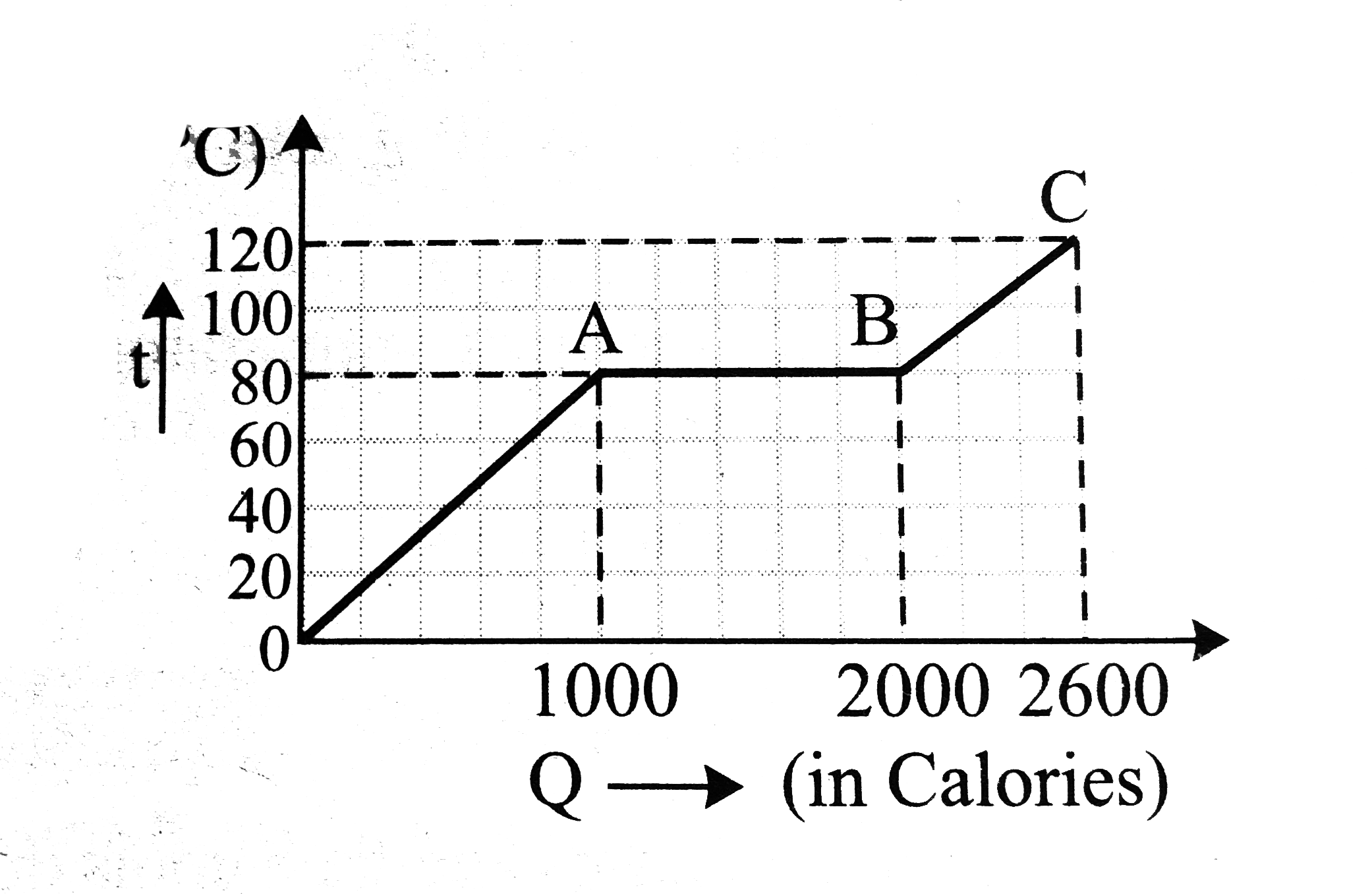
A substance is in the solid form at `0^@`C. The amount of heat added to this substance and its temperature are plotted in the following graph. If the relative specific heat capacity of the solid substance is 0.5, find from the graph (i) the mass of the substance, (ii) the specific latent heat of the melting process and (ii) the specific heat of the substance in the liquid state.
Specific heat capacity of water `=1000 cal//kg//K`05:32View SolutionTwo bodies of equal mass m are heated at a uniform rate under identical conditions . Their change in temperature are shown graphically in figure .
(i) what are their melting points ?
(ii) what is the ratio of their latent heats?
(iii) what is the ratio of their specific heats?
 04:02View Solution
04:02View Solution
The rectangular plate shown if Fig. 1.7 has an area `A_i`. If the temperature increases by `DeltaT`, each dimension increases according to `DeltaL=alphaLDeltaT`, where `alpha` is the average coefficient of linear expansion. Show that the increase in area is `DeltaA=2alphaA_iDeltaT`. What approzimation does this expansion assume?05:41View Solution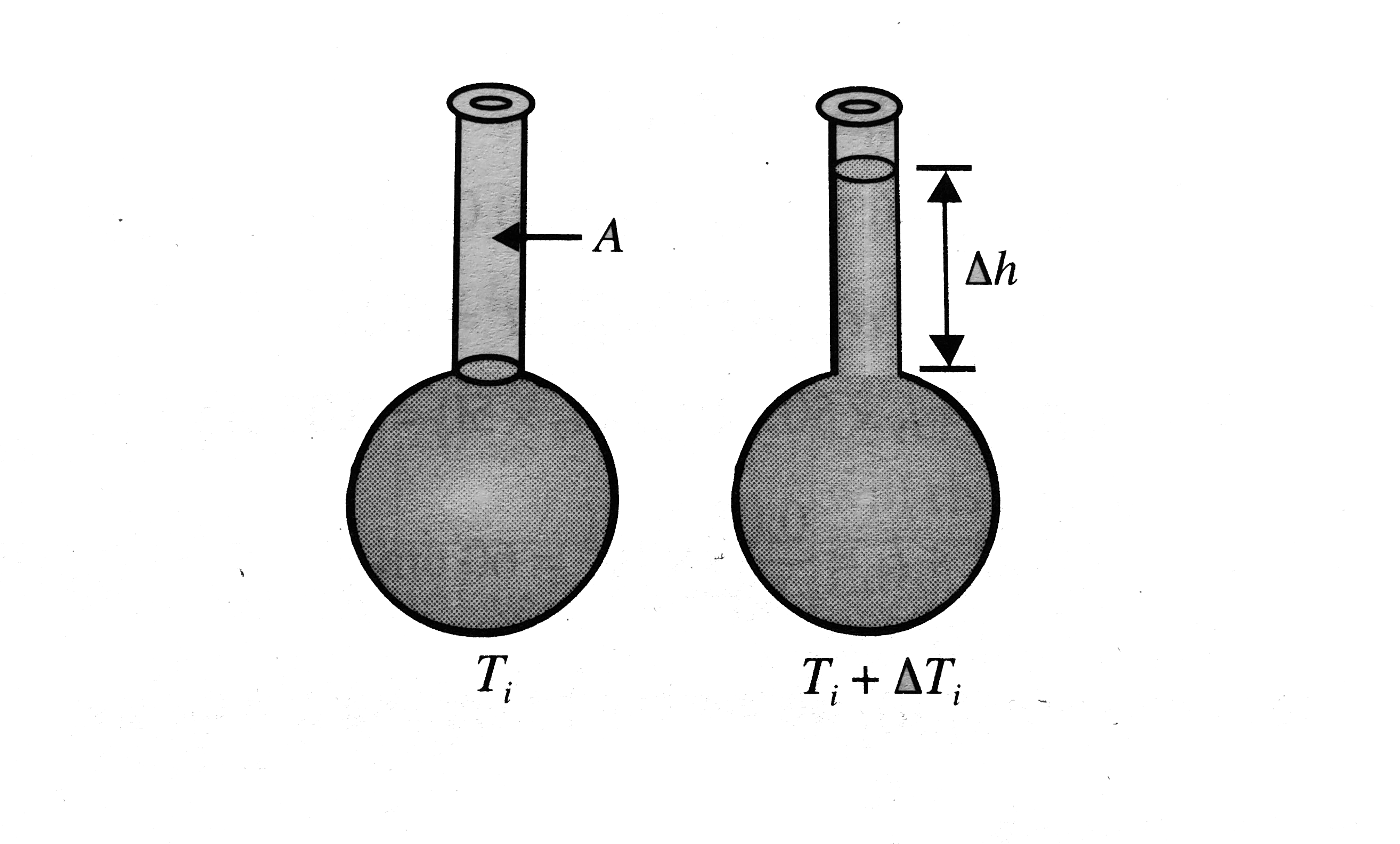
A mercury thermometer is constructed as shown if Fig. 1.9. The capillary tube has a diameter of 0.004 00 cm, and the bulb has a diameter of 0.250 cm. neglecting the expansion of the glass, find the change in height of the mercury column with a temperature change of 30.`0^@C`.04:25View SolutionA metal rod (A) of `25 cm` length expands by `0.050 cm` when its temperature is raised from `0^@ C` to `100^@ C`. Another rod (B) of a different metal of length `40 cm` expands by `0.040 cm` for the same rise in temperature. A third rod ( C) of `50 cm` length is made up of pieces of rods (A) and (B) placed end to end expands by `0.03 cm` on heating from `0^@ C` to `50^@ C`. Find the lengths of each portion of the composite rod.
05:37View SolutionDetermine the lengths of an iron rod and copper ruler at `0^@` C if the difference in their lengths at `50^@`C and `450^@`C is the same and is equal to 2 cm. the coefficient of linear expansion of iron`=12xx10^(-6)//K` and that of copper`=17xx10^(-6)//K`.
05:09View SolutionA steel ball initially at a pressure of `1.0 xx 10^5 Pa` is heated from `20^@ C` to `120^@ C` keeping its volume constant. Find the pressure inside the ball. Coefficient of linear expansion of steel `= 12 xx 10^(-6) C^(-1)` and bulk modulus of steel `= 1.6 xx 10^(11) N m^(-2)`
02:53View SolutionA steel rail 30 m long is firmly attached to the roadbed only at its ends. The sun raises the temperature of the rail by `5^@C`, causing the rail to buckle. Assuming that the buckled rail consists of two straight parts meeting in the centre, calculate how much the centre of the rail rises. coefficient of linear expansion of steel is `12xx10^(-6)//K`.
03:05View SolutionA small quantity of a liquid which dows not mix with water sinks to the bottom at `20^@`C, the densities of the liquid and water being 1021 and `990 kg//m^(3)`, respectively. To what teperature must the mixture be uniformly heated in order that the liquid forms globules which just float on water ? the cubical expansion of the liquid and water over the temperature ranges is `85xx10^(-5)//K` and `45xx10^(-5)//K` respectively.
02:40View SolutionA one litre flask contains some mercury. It is found that at different temperatures the volume of air inside the flask remains tha same. What is the volume of mercury in the flask? Given the cofficients of linear expansion of glass is `9xx10^(-6)//^(@)C` and the coefficient of volume expansion of mercury is `1.8xx10^(-4)//^(@)C`
04:24View SolutionA hollow aluminium cylinder 20.0 cm deep has an internal capacity of 2.000 L at `20.0^@` C. It is completely filled with tupentine and then slowly warmed to `80.0^@`C a. How much turpentine overflows? B. If the cylindre is then cooled back to `20.0^@`C, how far below the cylinder's rim dows the tupentine's surface recede?
03:56View SolutionA glass flask whose volume is exactly 1000`cm^3` at `0^@C` is filled level full of mercury at this temperature. When the flask and mercury are heated to `100^@C`, `15.2cm^3` of mercury overflows. The coefficient of cubical expansion of Hg is `1.82xx10^(-4)//^@ C`. Compute the coefficient of linear expansion of glass.
05:15View SolutionA `250cm^3` glass bottle is completely filled with water at `50^@C`. The bottle and water are heated to `60^@C`. How much water runs over if:
a. the expansion of the bottle is neglected:
b. the expansion of the bottle is included? Given the coefficient of areal expansion of glass `beta=1.2xx10^(-5)//K` and `gamma_("water")=60xx10^(-5)//^@C`.03:23View SolutionA solid floats in a liquid at `20^@`C with 75 % of it immersed. When the liquid is heated to `100^@`C, the same solid floats with `80%` of it immersed in the liquid. Calculate the coefficient of expansion of the liquid. Assume the volume of the solid to be constant.
05:50View SolutionA sinker of weight `w_0` has an apparent weight `w_1` when weighed in a liquid at a temperature `t_1 and w_2` when weight in the same liquid at temperature `t_2`. The coefficient of cubical expansion of the material of sinker is `beta`. What is the coefficient of volume expansion of the liquid.
06:50View SolutionA copper and a tungsten plate having a thickness `sigma=2`mm eacha re riveted together so that at `0^@`C They form a flat bimetallic plate. Find the average radius of cuvature of this plate at `t=200^@C`. The coefficients of linear expansion for copper and tungsten are
`alpha_(cu)=1.7xx 10^-5//K` and `alpha_(W)=0.4xx10^(-5)//K`, respectively.05:01View SolutionA clock with a brass pendulum shaft keeps correct time at a certain temperature.
a. How closely must the temperature be controlled if the clock is not to gain or lose more that 1 s a day? Does the answer depend on the period of the pendulum?
b. Will an increase of temperature cause the clock to gain or lose? `(alpha_("brass")=2 xx 10^(-5)//^(@)C)`03:37View SolutionA pendulum clock loses 12 s a day if the temperature is `40^(@)` and gains 4 s a day if the temperature is `20^(@)C`. The temperature at which the clock will show correct time, and the co-efficient of linear expansion `(alpha)` of the metal of the pendulum shaft are respectively :
06:56View SolutionA rod of length 2 m is at a temperature of `20^@` C. find the free expansion of the rod, if the temperature is increased to `50^@`C, then find stress produced when the rod is (i) fully prevented to expand, (ii) permitted to expand by 0.4mm. `Y=2xx10^(11)N//m^(2), alpha=15xx10^(-6//^(@))C`.
05:53View SolutionTwo rods of different metals having the same area of cross section A are placed between the two massive walls as shown is Fig. The first rod has a length `l_1`, coefficient of linear expansion `alpha_1` and Young's modulus `Y_1`. The correcsponding quantities for second rod are `l_2,alpha_2` and `Y_2`. The temperature of both the rods is now raised by `t^@C`.
i. Find the force with which the rods act on each other (at higher temperature) in terms of given quantities.
ii. Also find the length of the rods at higher temperature.
 04:25View Solution
04:25View SolutionTwo rods of equal cross sections, one of copper and the other of steel, are joined to form a composite rod of length 2.0 m at `20^@C`, the length of the copper rod is 0.5 m. When the temperature is raised to `120^@C`, the length of composite rod increases to 2.002m. If the composite rod is fixed between two rigid walls and thus not allowed to expand, it is found that the lengths of the component rods also do not change with increase in temperature. Calculate Young's moulus of steel. (The coefficient of linear expansion of copper, `alpha_c=1.6xx10^(-5@)C` and Young's modulus of copper is `1.3xx10^(13)N//m^(2)`).
05:33View SolutionA surveyor's 30 m steel tape is correct at a temperature of `20^@C`. The distance between two points, as measured by this tape on a day when the temperature is `35^@C`. Is 26m. What is the true distance between the point?
`(a_("steel")=1.2xx10^(-5@)C`)02:48View SolutionA barometer with a brass scale reads 755 mm on a day when the temperatures is `25^@C`. If the scale is correctly graduated at `0^@C`, find the true pressure at `0^@C` (interms of height of Hg) given that the coefficient of linear expansion of brass is `18xx10^(-6)//K`. Coefficient of cubical expansion of mercury`=182xx10^(-6)//K`.
03:11View SolutionAt room temperature (`25^@C`) the length of a steel rod is measured using a brass centimetre scale. The measured length is 20 cm. If the scale is calibrated to read accurately at temperature `0^@C`, find the actual length of steel rod at room temperature.
02:27View SolutionA refrigerator door is 150 cm high, 80 cm wide, and 6 cm thick. If the coefficient of conductivity is 0.0005 `cal//cm s^@C` and the inner and outer surfaces are at `0^@C` and `30^@C`, respectively, what is the heat loss per minute through the door, in calories?
02:29View SolutionA refrigerator is thermally equivalent to a box of cork board 90 mm thick and `6m^2` in iner surface area, the thermal conductivity of cork being `0.05 W//mK`. The motor of the refrigerator runs `15%` of the time while the door is closed. The inside wall of the door, when it is closed is kept, on an average, `22^@C` below the temperature of the outside wall. The rate at which heat is taken from the interior wall while the motor is running is
03:08View SolutionWater is being boiled in a flat bottomed kettle placed on a stove . The area of the bottom is `300 cm^(2)` and the thickness is 2 mm. If the amount of steam produced is 1 g `min^(-1)`, then the difference of the temperature between the inner and outer surfaces of the bottom is (thermal conductivity of the material of the lettle =`0.5 cal cm^(-1)^(@)C s^(-1)` and latent heat of the steam is equal to to `540 cal g^(-1)`)
02:57View SolutionA closed cubical box is made of perfectly insulating material and the only way for heat to enter or leave the box is through two solid cylindrical metal plugs, each of cross sectional area `12cm^(2)` and length 8cm fixed in the opposite walls of the box. The outer surface of one plug is kept at a temperature of `100^(@)C` . while the outer surface of the plug is maintained at a temperature of `4^(@)C` . The thermal conductivity of the material of the plug is `2.0Wm^(-1)C^(-1)` . A source of energy generating 13W is enclosed inside the box. Find the equilibrium temperature of the inner surface of the box assuming that it is the same at all points on the inner surface.
07:00View SolutionTwo metal cubes A and B of same size are arranged as shown in figure. The extreme ends of the combination are maintained at the indicated temperature. The arrangement is thermally insulated. The coefficients of thermal conductivity of A and B are `300W//m^@C` and `200W//m^@C`, respectively. After steady state is reached, the temperature t of the interface will be________.
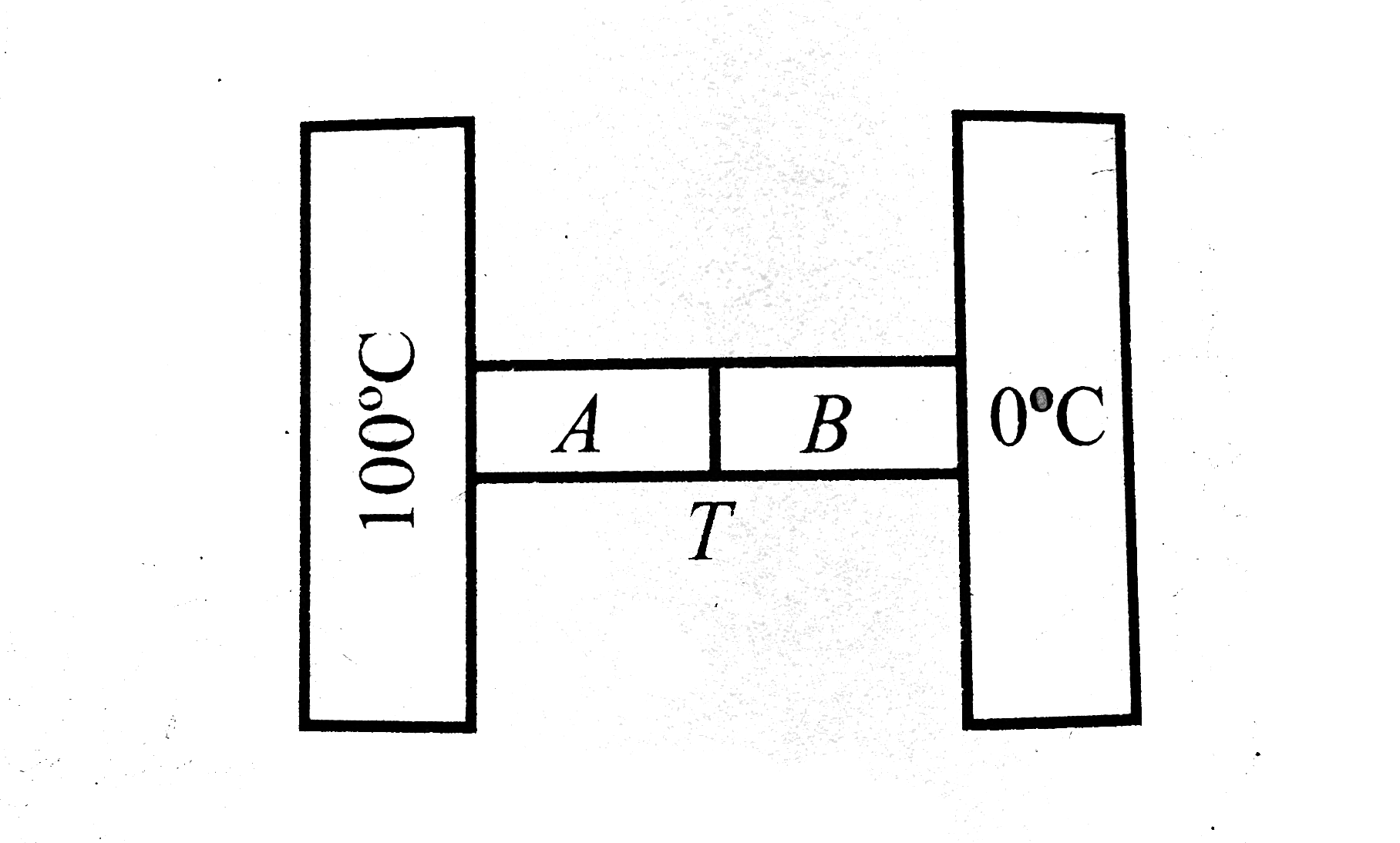 03:39View Solution
03:39View Solution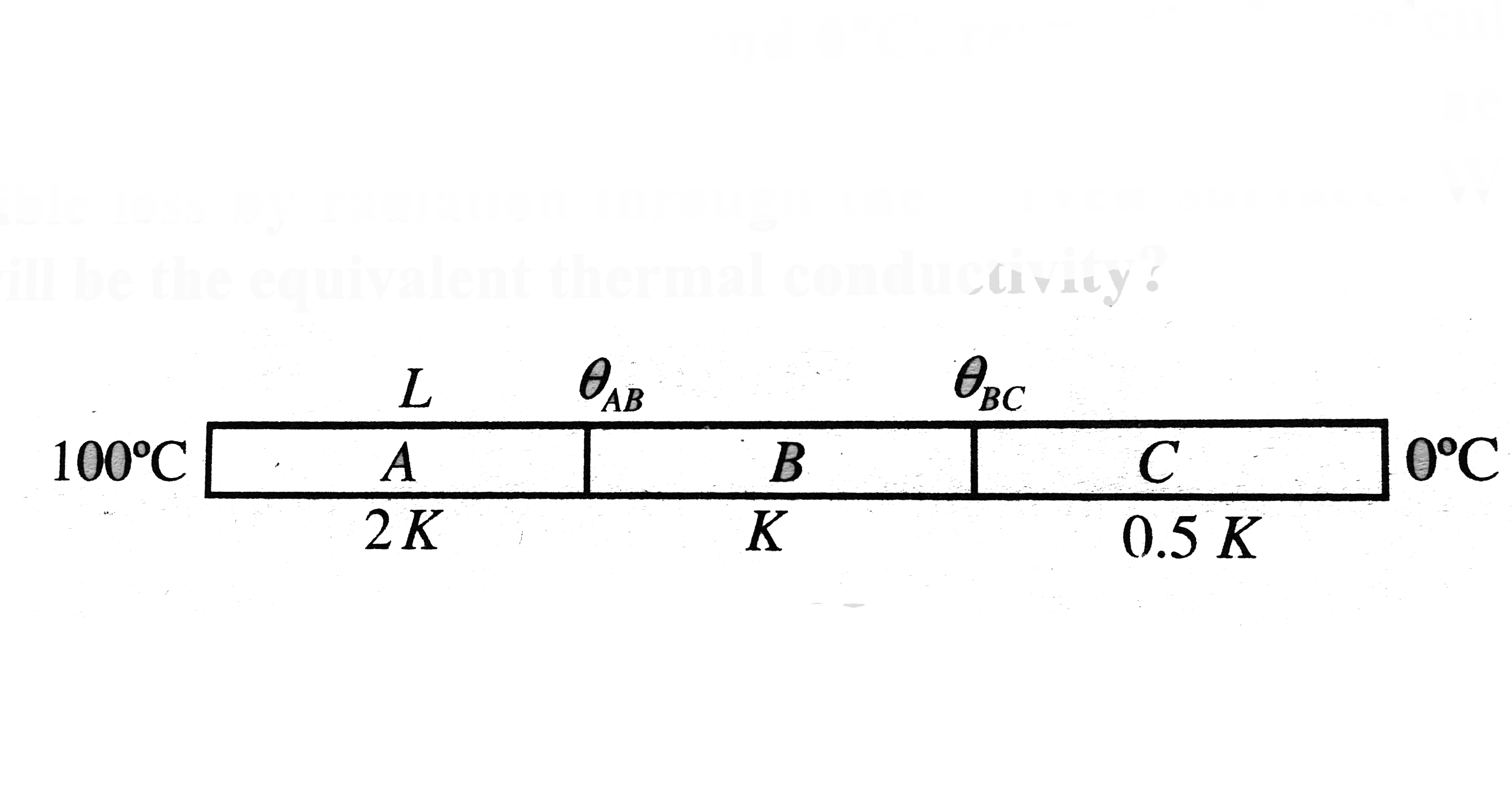
Three cylindrical rods A, B and C of equal lengths and equal diameters are joined in series as shown if Fig. Their thermal conductivities are 2K, K and 0.5K, respectively. In steady state, if the free ends of rods A and C are at `100^@C` and `0^@C`, respectively, calculate the temperature at the two junction points. Assume negligible loss by radiaiotn through the curved surface. What will be the equivalent thermal conductivity?08:55View SolutionTwo walls of thickness in the ratio 1:3 and thermal conductivities in the ratio 3:2 form a composite wall of a building. If the free surfaces of the wall be at temperatures `30^@C` and `20^@C`, respectively, what is the temperature of the interface?
04:57View SolutionOne end of a uniform brass rod 20 cm long and `10 cm^2` cross-sectional area is kept at `100^@C`. The other end is in perfect thermal contact with another rod of identical cross-section and length 10 cm. The free end of this rod is kept in melting ice and when the steady state has been reached, it is found that 360 g of ice melts per hour. Calculate the thermal conductivity of the rod, given that the thermal conductivity of brass is `0.25 cal//s cm^@C and L = 80 cal//g`.
06:18View SolutionAn electric heater is used in a room of total wall area `137m^(2)` to maintain a temperature of `20^(@)C` inside it, when the outside temperature is `-10^(@)C` .The walls have three different layers of materials. The innermost layer is of wood of thickness 2.5cm, the middle layer is of cement of thickness 1.0cm and the outermost layer is of brick of thickness 25.0cm. Find the power of the electric heater. Assume that there is no heat loss through the floor and the celling. The thermal conductivities of wood, cement and brick are `0.125Wm^(-1)C^(-1)` , `1.5Wm^(-1)C^(-1)` . and `1.0Wm^(-1)C^(-1)` respectively.
04:57View Solution
Three identical rods of length 1 m each, having cross-sectional area of `1cm^2` each and made of aluminium, copper and steel, respectively, are maintained at temperatures of `12^@C`,`4^@C` and `50^@C`, respectively, at their separate ends. Find the teperature of their common junction.
`[K_(Cu)=400 W//m-K,K_(Al)=200 W//m-K,K_("steel")=50 W//m-K]`06:27View SolutionAn electric heater of surface area `200cm^2` emits radiant energy of 60 kJ at time interval of 1 min. Determine its emissive power. If its emissivity be 0.45, what would be the radiant energy emitted by a black body in one hour, identical to the electrical heater in all respects?
04:18View SolutionA spherical black body with a radius of `12` cm radiates `450` watt power at `500 K`. if the radius were halved and the temperature doubled, the power radiated in watt would be
03:37View SolutionThe operating temperature of an in candescent bulb (with tungsten filament) of power 60 W is 3000 K. If the surface area of the filament be 25 `mm^2`, find its emissivity e.
03:00View SolutionA copper sphere is suspended in an evacuated chamber maintained at 300 K . The sphere is maintained at a constant temperature of 500 K by heating it electrically. A total of 210 W of electric power is needed to do it. When the surface of the copper sphere is completely blackened, 700 W is needed to maintain the same temperature of the sphere. Calculate the emissivity of copper.
03:35View SolutionTwo bodies A and B have thermal emissivities of 0.01 and 0.81 respectively. The outer surface areas of the two bodies are same. The two bodies emit total radiant power at the same rate. The wavelength `lambda_B` corresponding to maximum spectral radiancy from B is shifted from the wavelength corresponding to maximum spectral radiancy in the radiation from A by 1.0 `mum`. If the temperature of A is 5802 K, calculate (a) the temperature of B, (b) wavelength `lambda_B`.
03:45View SolutionThe emissivity of tungsten is aproximately 0.35. A tungsten sphere 1 cm in radius is suspended within a large evacuated enclosure whose walls are at 300 K. What power input is required to maintain the sphere at a temperature of 3000 K if heat conduction along the support is neglected?`sigma=5.67xx10^-8` SI units.
02:47View SolutionA solid copper sphere of density `rho`, specific heat c and radius r is at temperature `T_1`. It is suspended inside a chamber whose walls are at temperature `0K`. What is the time required for the temperature of sphere to drop to `T_2`? Take the emmissivity of the sphere to be equal to e.
06:49View SolutionTwo solid copper spheres of radii `r_1=15cm` and `r_2=20cm` are both at a temperature of `60^@`C. If the temperature of surrounding is `50^@C`, then find
a. The ratio of the heat loss per second from their surfaces initially.
b. the ratio of rates of cooling initially.08:16View SolutionTwo identical spheres A and B are suspended in an air chamber which is maintained at a temperature of `50^@C`. Find the ratio of the heat lost per second from the surface of the spheres if
a. A and B are at temperatures `60^@C` and `55^@C`, respectively.
b. A and B are at temperatures `250^@C` and `200^@C`, respectively.05:51View SolutionA body cools down from `60%=^@C` to `55^@C` in 30 s. Using newton's law of cooling calculate the time takken by same body to cool down from `55^@C` to `50^@C`. Assume that the temperature of surrounding is `45^@C`.
04:51View SolutionA body cools from `60^(@)`C to `50^(@)`C in 10 min. If room temperature is `95^(@)`C. Temperature of body at the end of next 10 min, will be
01:19View SolutionA thin brass rectangular sheet of sides 10 cm and 5 cm is heated in a furnace to `500^(@)` C and taken out. How much electric power is needed to maintain the sheet at this temperature ? Its emissivity is 0.25.
03:44View SolutionA hot body placed in air is cooled down according to Newton's law of cooling, the rate of decrease of temperature being `k` times the temperature difference from the surrounding. Starting from `t=0` , find the time in which the body will lose half the maximum heat it can lose.
04:34View SolutionThe spectral energy distribution of the sun has a maximum at `4754Å`. If the temperature of the sun is 6050 K, what is the temperature of a star for which this maximum is at `9506Å`?
02:58View SolutionThe light from th sun is found to have a maximum intensity near the wavelength of `470nm`. Assuming that the surface of the sun emits as a blackbody, calculate the temperature of the surface of the sun.
03:12View SolutionIf the filament of a 100 W bulb has an area `0.25cm^2` and behaves as a perfect black body. Find the wavelength corresponding to the maximum in its energy distribution. Given that Stefan's constant is `sigma=5.67xx10^(-8) J//m^(2)s K^(4)`.
03:00View SolutionA hot black body emits the enegy at the rate of 16 `Jm^-2s^-1` and its most intense radiation corresponds to 20000`Å`. When the temprerature of this body is further increased and its most intense radiation corresponds to `10000Å`, then find the value of energy radiated in `Jm^-2s^-1`.
04:23View SolutionThe intensity of solar radiation just outside the earth's atmosphere is measured to be `1.4 kW//m^2`. If the radius of the sun `7xx10^8m`, while the earth-sun distance is `150xx10^6km`, then find
i. the intensity of salr radiation at the surface of the sun.
ii. the temperature at the surface of the sun assuming it to be a black body,
iii. the most probable wavelength in solar radiation.03:47View SolutionThe earth receives solor radiation at a rate of `8.2Jcm^(-2)min^(-1)` . Assuming that the sun radiates like a blackbody, calculate the surface temperature of the sun. The angle subtended by the sun on the earth is `0.53^(@)` and the stefan constant `sigma=5.67xx10^(-s)Wm^(-2)K^(-4)` .
04:31View SolutionConsider a cylindrical container of cross-section area A length h and having coefficient of linear expansion `alpha_(c)`. The container is filled by liquid of real expansion coefficient `gamma_(L)` up to height `h_(1)`. When temperature of the system is increased by `Deltatheta` then
(a). Find out the height, area and volume of cylindrical container and new volume of liquid.
(b). Find the height of liquid level when expansion of container is neglected.
(c). Find the relation between `gamma_(L)` and `alpha_(c)` for which volume of container above the liquid level
(i) increases
(ii). decreases
(iii). remains constant.
(d). On the surface of a cylindrical container a scale is attached for the measurement of level of liquid of liquid filled inside it. If we increase the temperature of the temperature of the system by `Deltatheta`, then
(i). Find height of liquid level as shown by the scale on the vessel. Neglect expansion of liquid.
(ii). Find the height of liquid level as shown by the scale on the vessel. Neglect expansion of container.
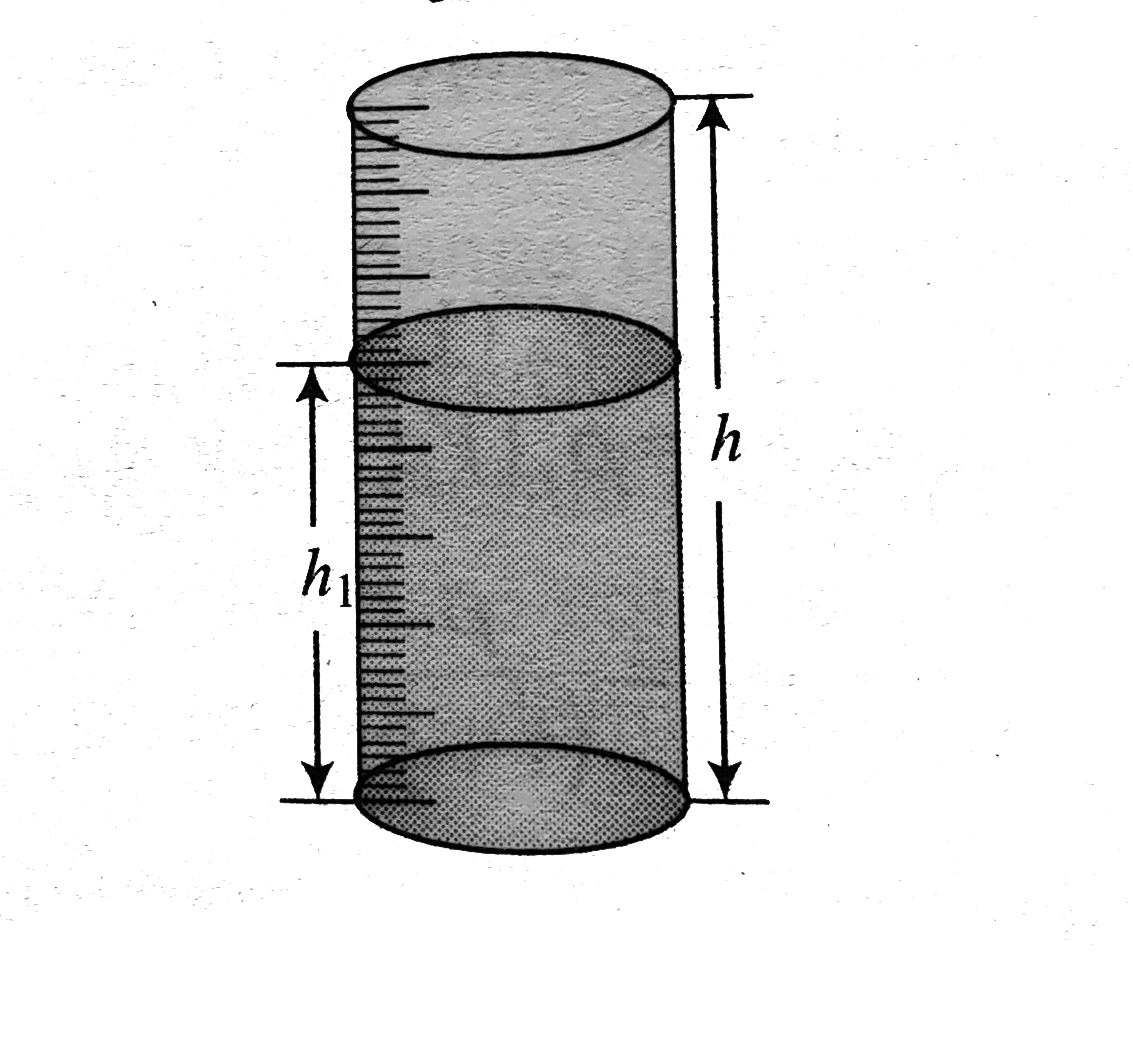 12:47View Solution
12:47View Solution
Illustration questions and complete solutions for chapter CALORIMETRY of CENGAGE PHYSICS (ENGLISH) of Class 11
